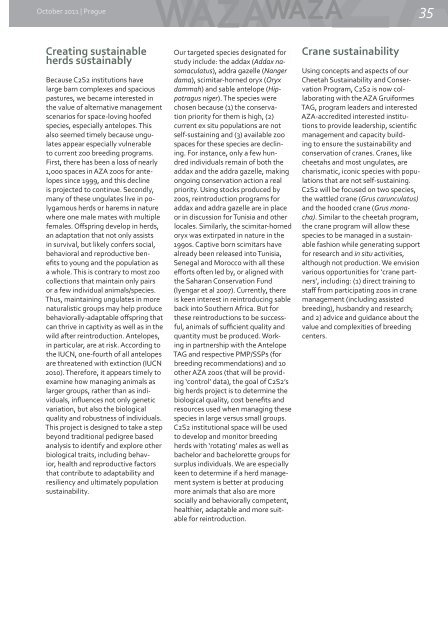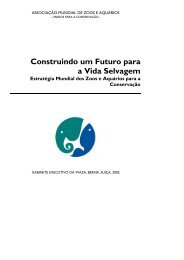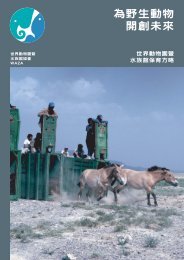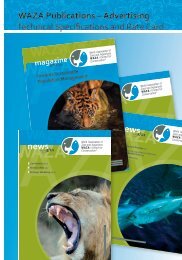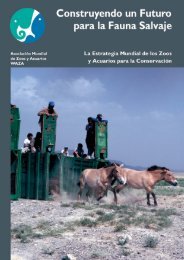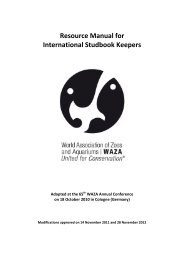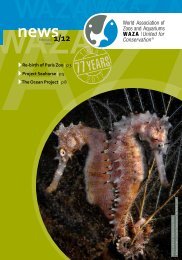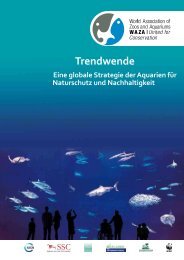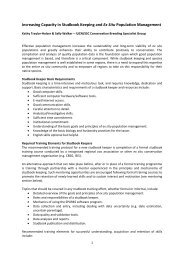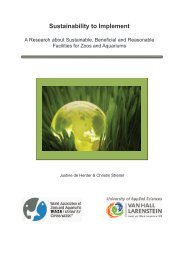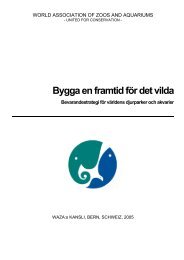Prague - WAZA
Prague - WAZA
Prague - WAZA
Create successful ePaper yourself
Turn your PDF publications into a flip-book with our unique Google optimized e-Paper software.
October 2011 | <strong>Prague</strong> 35<br />
Creating sustainable<br />
herds sustainably<br />
Because C2S2 institutions have<br />
large barn complexes and spacious<br />
pastures, we became interested in<br />
the value of alternative management<br />
scenarios for space-loving hoofed<br />
species, especially antelopes. This<br />
also seemed timely because ungulates<br />
appear especially vulnerable<br />
to current zoo breeding programs.<br />
First, there has been a loss of nearly<br />
1,000 spaces in AZA zoos for antelopes<br />
since 1999, and this decline<br />
is projected to continue. Secondly,<br />
many of these ungulates live in polygamous<br />
herds or harems in nature<br />
where one male mates with multiple<br />
females. Offspring develop in herds,<br />
an adaptation that not only assists<br />
in survival, but likely confers social,<br />
behavioral and reproductive benefits<br />
to young and the population as<br />
a whole. This is contrary to most zoo<br />
collections that maintain only pairs<br />
or a few individual animals/species.<br />
Thus, maintaining ungulates in more<br />
naturalistic groups may help produce<br />
behaviorally-adaptable offspring that<br />
can thrive in captivity as well as in the<br />
wild after reintroduction. Antelopes,<br />
in particular, are at risk. According to<br />
the IUCN, one-fourth of all antelopes<br />
are threatened with extinction (IUCN<br />
2010). Therefore, it appears timely to<br />
examine how managing animals as<br />
larger groups, rather than as individuals,<br />
influences not only genetic<br />
variation, but also the biological<br />
quality and robustness of individuals.<br />
This project is designed to take a step<br />
beyond traditional pedigree based<br />
analysis to identify and explore other<br />
biological traits, including behavior,<br />
health and reproductive factors<br />
that contribute to adaptability and<br />
resiliency and ultimately population<br />
sustainability.<br />
Our targeted species designated for<br />
study include: the addax (Addax nasomaculatus),<br />
addra gazelle (Nanger<br />
dama), scimitar-horned oryx (Oryx<br />
dammah) and sable antelope (Hippotragus<br />
niger). The species were<br />
chosen because (1) the conservation<br />
priority for them is high, (2)<br />
current ex situ populations are not<br />
self-sustaining and (3) available zoo<br />
spaces for these species are declining.<br />
For instance, only a few hundred<br />
individuals remain of both the<br />
addax and the addra gazelle, making<br />
ongoing conservation action a real<br />
priority. Using stocks produced by<br />
zoos, reintroduction programs for<br />
addax and addra gazelle are in place<br />
or in discussion for Tunisia and other<br />
locales. Similarly, the scimitar-horned<br />
oryx was extirpated in nature in the<br />
1990s. Captive born scimitars have<br />
already been released into Tunisia,<br />
Senegal and Morocco with all these<br />
efforts often led by, or aligned with<br />
the Saharan Conservation Fund<br />
(Iyengar et al 2007). Currently, there<br />
is keen interest in reintroducing sable<br />
back into Southern Africa. But for<br />
these reintroductions to be successful,<br />
animals of sufficient quality and<br />
quantity must be produced. Working<br />
in partnership with the Antelope<br />
TAG and respective PMP/SSPs (for<br />
breeding recommendations) and 10<br />
other AZA zoos (that will be providing<br />
‘control’ data), the goal of C2S2’s<br />
big herds project is to determine the<br />
biological quality, cost benefits and<br />
resources used when managing these<br />
species in large versus small groups.<br />
C2S2 institutional space will be used<br />
to develop and monitor breeding<br />
herds with ‘rotating’ males as well as<br />
bachelor and bachelorette groups for<br />
surplus individuals. We are especially<br />
keen to determine if a herd management<br />
system is better at producing<br />
more animals that also are more<br />
socially and behaviorally competent,<br />
healthier, adaptable and more suitable<br />
for reintroduction.<br />
Crane sustainability<br />
Using concepts and aspects of our<br />
Cheetah Sustainability and Conservation<br />
Program, C2S2 is now collaborating<br />
with the AZA Gruiformes<br />
TAG, program leaders and interested<br />
AZA-accredited interested institutions<br />
to provide leadership, scientific<br />
management and capacity building<br />
to ensure the sustainability and<br />
conservation of cranes. Cranes, like<br />
cheetahs and most ungulates, are<br />
charismatic, iconic species with populations<br />
that are not self-sustaining.<br />
C2S2 will be focused on two species,<br />
the wattled crane (Grus carunculatus)<br />
and the hooded crane (Grus monacha).<br />
Similar to the cheetah program,<br />
the crane program will allow these<br />
species to be managed in a sustainable<br />
fashion while generating support<br />
for research and in situ activities,<br />
although not production. We envision<br />
various opportunities for ‘crane partners’,<br />
including: (1) direct training to<br />
staff from participating zoos in crane<br />
management (including assisted<br />
breeding), husbandry and research;<br />
and 2) advice and guidance about the<br />
value and complexities of breeding<br />
centers.


